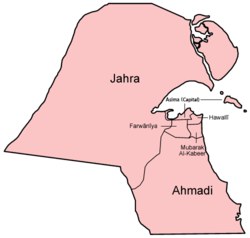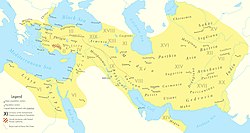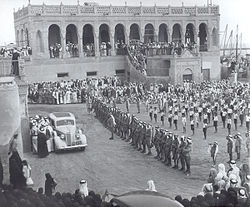Kuwait
Kuwait (Arabic: الكويت) is a small Arab country (about 17,819 square kilometers) in the Middle East.
State of Kuwait | |
|---|---|
| Anthem: | |
 Location of Kuwait (green) | |
 | |
| Capital and largest city | Kuwait City 29°22′N 47°58′E / 29.367°N 47.967°E |
| Official languages | Arabic |
| Ethnic groups | |
| Religion | Islam |
| Demonym(s) | Kuwaiti |
| Government | Unitary constitutional monarchy[1] |
• Emir | Mishal Al-Ahmad Al-Jaber Al-Sabah |
| Ahmad Al-Abdullah Al-Sabah | |
| Ahmed Al-Sadoun | |
| Legislature | National Assembly |
| Establishment | |
• Independence from the Emirate of Al Hasa | 1752 |
| 1913 | |
• End of treaties with the United Kingdom | 19 June 1961 |
| Area | |
• Total | 17,818 km2 (6,880 sq mi) (152nd) |
• Water (%) | negligible |
| Population | |
• 2016 estimate | 4,052,584[2] (128th) |
• 2005 census | 2,213,403[3] |
• Density | 200.2/km2 (518.5/sq mi) (61st) |
| GDP (PPP) | 2018 estimate |
• Total | $303 billion[4] |
• Per capita | $69,669[4] (5th) |
| GDP (nominal) | 2018 estimate |
• Total | $118.271 billion[4] (55th) |
• Per capita | $28,199[4] (23rd) |
| HDI (2017) | very high · 56th |
| Currency | Kuwaiti dinar (KWD) |
| Time zone | UTC+3 (AST) |
| Date format | dd/mm/yyyy (CE) |
| Driving side | right |
| Calling code | +965 |
| ISO 3166 code | KW |
| Internet TLD | .kw |
Website www.e.gov.kw | |
| |


Kuwait is the most socially progressive country in the Gulf region. It has a small and rich economy. It has about 96 billion barrels of crude oil reserves. Crude oil reserves are the oil that is still under the ground and has not yet been cleaned up. Kuwait has 10% of all of the oil reserves in the world. The country makes a lot of money by selling oil. This money is almost half of all the money the country makes. The oil money is also 95% of the money made by selling things to different countries (people call that exports). Also, the oil money is 80% of the money the government makes. Kuwait is now talking with oil companies of other countries to make oil fields in the northern part of the country.
Kuwait's weather makes farming hard (too little rain). Instead of farming, the country catches fish and buys food from other countries. About 75% of the country's water to drink has to be distilled (have the salt removed) or purchased from other countries.
In 1990, Iraq invaded (brought an army in to fight against) Kuwait. This started the first Gulf War. Kuwait's official religion is Islam, although 15% of its population are Christian or Hindu. Arabic is mostly spoken in Kuwait but English is widespread among Kuwaitis (residents of Kuwait). Kuwait is one of the few nations that has education for every age.
Demographics
As of 2023, Kuwait has a population of 4.82 million people of which 1.53 million are Kuwaiti citizens while the remaining 3.29 million are foreign nationals from over 100 countries.[6] Of the total population of Kuwait, only 31% are Kuwaitis while around 69% are Non-Kuwaitis.[7] Indians are the biggest Expat community in Kuwait making 21% of the population followed by Egyptians who are 13% of the population.[7]
Population (in thousands) for 2004: 2595. CBR (per 1000) for 2004: 19.4. CDR (per 1000). Growth rate (%) for 2004: 1.9. For 1992-2002: 2.1. The total fertility rate for 2002 is 2.7. Percent population living in urban areas is 96.2 in 2003. Per capita gross national income ($) in 2002: 612. Population density (per square kilometer) in 2000: 107.4. Infant mortality rate (per 1000) for 2005: 9.95. Adult literacy rate: 85%. Female literacy rate: 81% as of 2002.
Governorates
Kuwait is divided into 6 governorates. The governorates are divided into districts, And the establishment of the governorates of Kuwait dates back to the Emiri Decree No. 6 issued in 1962, which divided Kuwait into three governorates: the Capital Governorate, Hawalli Governorate and Al-Ahmadi Governorate. The decree clarified the work of the governor, his subordination of the governor to the Ministry of Interior, and his responsibility towards security, provided that the Ministry of Interior issues the necessary decisions to indicate the limits of the governor's jurisdiction. There have been some changes regarding the governorates of Kuwait, which we summarize as follows:
. On November 14, 1979: Some provisions of the administrative division decree were amended so that a fourth governorate, Al-Jahra Governorate, was added.
. On October 12, 1988: The first article of the article was amended to divide Kuwait into five governorates by adding Al-Farwaniyah Governorate.
. On November 27, 1999: Emiri Decree No. 290 was issued to add a sixth governorate, Mubarak Al-Kabeer Governorate.
Thus, Kuwait has become administratively divided into six governorates, each affiliated with several regions. Warba Island and Bubiyan Island belong to the Jahra Governorate, while the rest of the islands belong to the Capital Governorate.

| ||||||||||||||||||||||||
|---|---|---|---|---|---|---|---|---|---|---|---|---|---|---|---|---|---|---|---|---|---|---|---|---|
| Subdivision | Capital | Area km² |
Population Census of 2005 |
Created | ||||||||||||||||||||
| Al Asimah (Al Kuwayt)2) | Al Kuwait | 200 | 261 013 | original Governorate | ||||||||||||||||||||
| Hawalli | Hawalli District | 84 | 487 514 | original Governorate | ||||||||||||||||||||
| Al Farwaniyah | Al Farwaniyah | 190 | 622 123 | 1988 from Al Asimah | ||||||||||||||||||||
| Al Ahmadi1) | Al Ahmadi | 5 120 | 393 861 | 1946 from Al Asimah | ||||||||||||||||||||
| Al Jahra3) | Al Jahra | 12 130 | 272 373 | 1979 from Al Asimah | ||||||||||||||||||||
| Mubarak Al-Kabeer | Mubarak Al-Kabeer | 94 | 176 519 | November 1999 from Hawalli | ||||||||||||||||||||
| TOTAL | 17 818 | 2 213 403 | ||||||||||||||||||||||
| 1) The Neutral Zone was dissolved on 18 December 1969, and the northern part with 2590 km² was added to Al Ahmadi (with small part in the northwest added to Al Jahra) | ||||||||||||||||||||||||
| 2) including the islands of Failaka, Miskan, and Auhah | ||||||||||||||||||||||||
| 3) including the islands of Warbah and Bubiyan | ||||||||||||||||||||||||
Kuwait Media
National anthem of Kuwait (instrumental)
The Achaemenid Empire at its greatest territorial extent
The Seleucid Empire at its greatest extent
Marine Museum in Kuwait City. Demonstrates the founding of Kuwait as a sea port for merchants.
The Kuwait Red Fort in Al Jahra
Celebration at Seif Palace in 1944
HMS Victorious taking part in Operation Vantage in July 1961
Kuwaiti oil fires set by retreating Iraqi forces in 1991
Iraqi Armed Forces tanks in Kuwait City of Iraqi-occupied Kuwait on 2 August 1990 during the Iraqi invasion of Kuwait that began the Gulf War.
Related pages
References
- ↑ 1.0 1.1 "Kuwait". The World Factbook. Central Intelligence Agency. 10 April 2015. Archived from the original on 2 July 2014.
- ↑ "World Population Prospects: The 2017 Revision". ESA.UN.org (custom data acquired via website). United Nations Department of Economic and Social Affairs, Population Division. Retrieved 10 September 2017.
- ↑ "Population of Kuwait". Kuwait Government Online. 2013. Archived from the original on 17 January 2013.
- ↑ 4.0 4.1 4.2 4.3 "IMF Report for Selected Countries and Subjects : Kuwait". International Monetary Fund. Archived from the original on 24 February 2018. Retrieved 1 April 2017.
- ↑ "2018 Human Development Report". United Nations Development Programme. 2018. Archived from the original on 14 September 2018. Retrieved 14 September 2018.
- ↑ "Kuwait: Population surpasses pre-Covid peak in mid-2023". NBK Group. https://www.nbk.com/dam/jcr:b27832e5-1d41-4ff4-bd06-ee2e77fae61b/NBKEconomicInsightKuwaitPopulation&LF20230904E.pdf. Retrieved 25 February 2024.
- ↑ 7.0 7.1 Jabr, Ahmad (22 February 2024). "Expats still make up two thirds of population as some communities grow". Kuwait Times.










